 |
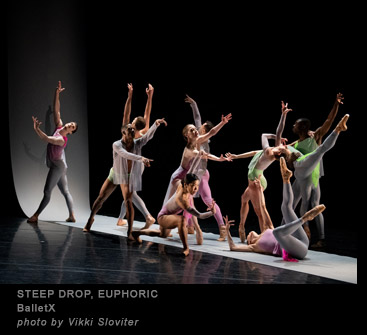
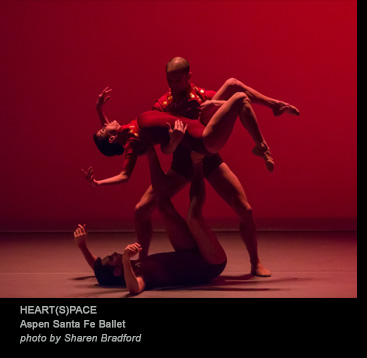

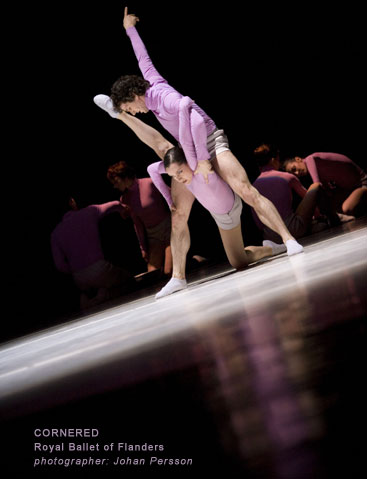
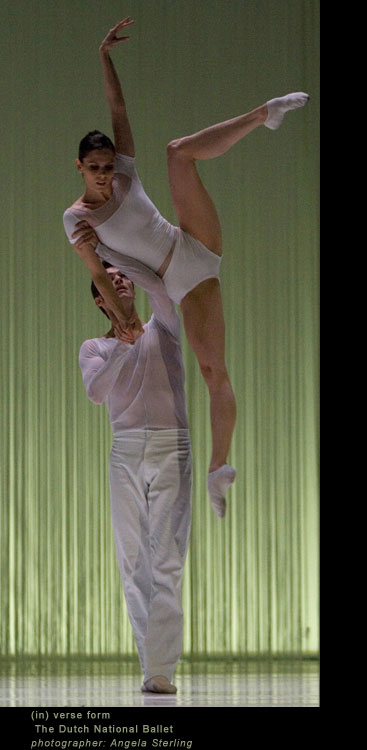
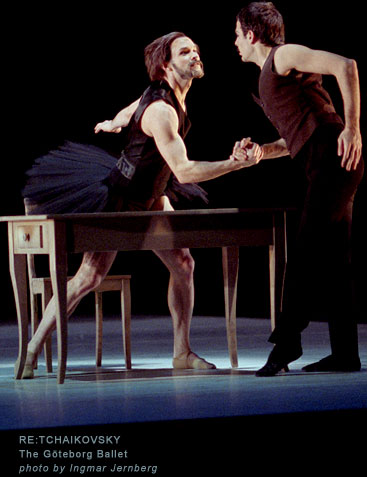
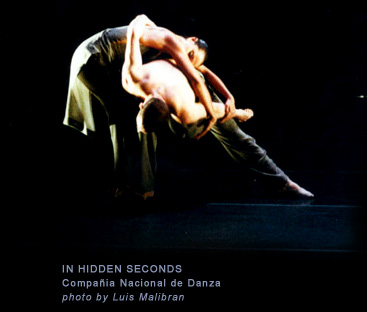 |




|
I have been on the prowl for great art for a long time and when I find it, it's certainly something to be celebrated and cherished... Dance-wise, it helps to begin with great music, and Nicolo Fonte has done just that with his work, "Giants Before Us", set to piano music of Liszt and Schubert - and how nice that the audience was treated to live piano accompaniment by an equally superb pianist, Portlander Hunter Noack. Noack (and piano) appeared on the top of an 8-foot platform, theatre magic courtesy of a hydraulic lift... and some of the best, most expressive and greatest keyboard works of Liszt and Schubert. 10 men and one woman - what a combo! While mostly a work for the 10 men, once the woman enters (the wonderful Xuan Cheng) and she "chooses" Peter Franc, theirs is a pas de deux central to the dance. I enjoyed how playful the interactions between the men were and the times when one or the other were lifted and carried about. Overall, this was a very good program of shorter works, finishing with one ("Giants Before Us") that could and should be seen and experienced again and again.
The standout of the night, Nicolo Fonte's "Steep Drop, Euphoric", is a gleefully dramatic and technically challenging closer. Lights come up on the face and torso of Chloe Perkes, suspended in midair, the most striking opening of the program. Upstage of Perkes, a strip of white marley flooring hangs from the ceiling, ending in a roll on the stage. Diagonally downstage, a row of theatrical lights are hung low overhead, in sight of the audience. As the dancers whirl around in gauzy neon pink and green, clawing the space with their hands to the relentless strings of Ezio Bosso, these theatrical set-pieces put my mind at ease; there's a self-awareness of the high drama of this choreography. Perkes delivers an emotional solo, pushing herself forward across the floor, unspooling the roll of marley with her pointe shoes until it stretches across the stage, before rolling herself up in it. She runs the length of white, and hurtles up the panel vertically (the illusion assisted by her fellow dancers). Fonte plays with the rolling musicality and deep silences of Bosso's music. Just as we can hear the musician's breath and the attack of the bow in Bosso's recordings, we hear the breath of the dancers and see the power and fluidity of their movements. Half the company sits as audience to watch the rest dance under the theatrical lights, and I'm reminded of my earlier imagining of all these dancers' recital years. This is what dance can be, Fonte seems to be saying, and isn't it glorious?
The Spring Series program closed with Nicolo Fonte's "Steep Drop, Euphoric", a gorgeous, emotionally rich piece. From the first moments, when a single dancer stands silhouetted against a long scroll of material, I was so caught up in the beauty and drama of what was taking place on stage it felt as though I was holding my breath. Fonte's choreography effectively translates the inner movements of the mind into physical movement. It felt like we were watching a psychological drama play out among the dancers on stage. Rather than the deliberate symbolism of the first two numbers, more was left to the audience's imagination here. For example, the dance was structured around a long scroll of fabric hanging from the ceiling in the back of the stage that was gradually unrolled diagonally across the stage throughout the piece. The dancers engaged with this scrolling material, alternately conforming to and rebelling against its boundaries. Throughout the piece, the lighting cast strong silhouettes against the scroll, creating a contrast between the dancers' physical selves and shadow selves, between body and mind. While the atmospheric music by Ezio Bosso and Ólafur Arnalds enhanced the mystery and beauty of the dance, the choreography stood on its own, and I would have been just as enthralled watching the troupe dance in silence. Fonte shows that choreographers don't need to rely on external factors like music or seek inspiration from other art forms to create compelling work that speaks to audiences.
... "Fox on the Doorstep" is an aesthetic wonder - rich in design and depth, contrasts and textures. Dancers seem to adopt a new dialect within the ballet language when performing Fonte's choreography. Whether his messages are heavily abstracted or nonexistent, audience members will come away inspired spiritually and emotionally. "Fox"... received a standing ovation.
The program opens with the world premiere of Nicolo Fonte's stunning "Ghost Stories." A work for five couples, plus rising corps member Albert Gordon... "Ghost Stories" begins with lighting designer Brad Fields' dramatic introduction of Oksana Maslova, revealed on the darkened stage by a column of light. Fonte's choreography is endlessly inventive, notably in a trio featuring Sterling Baca, Ian Hussey, and Dayesi Torriente. Fonte creates unexpected movements and powerful pauses, echoing the cascade of sound provided by the music of Ezio Bosso and Max Richter.
The novelty and freshness of Nicolo Fonte's "Beautiful Decay" never wore off. From start to finish, I thoroughly enjoyed how he took a serious subject (the cycle of life) and turned it into an interesting and exciting full-length dance work in two parts. While telling the outline of a story - the story of human life, it was never maudlin nor sad, but upbeat, very energetic, and interspersed with moments of poetic poignancy. The dancers were given very athletic and technical work to do, which they did with great clarity and elan. There was also quite a bit of partnering - groups of duos, an occasional trio, but no one person being shown off; a group/team work.
"Grace Action", by Mr. Fonte closes the program and was the company's greatest hit with the audience. Anyone can see why. It has stunning lighting by Brad Fields, with 12 searchlight-like lamps creating different beams across the stage (we might be in a planetarium); the dancers are dressed by Martha Chamberlain in midnight blue; and the Philip Glass music is easy on the ear. Mr. Fonte's dances are likewise very easy on the eye, and this is the finest work I have seen by him. It features handsome group configurations and arresting motifs, notably a descending gesture of one curved arm, variously embroidered into the dances... the prettiness is exceptional.
Wonderful, wonderful - and yet again - wonderful. Wednesday's world premiere of "Beasts", an evening-length work made for BalletX by Nicolo Fonte, was so good, I wanted to see it again while it was still happening. "Beasts" gives BalletX the choreography that is worthy of its 10 superlative dancers, allowing them to show off both their astonishing technique and their impressive stylistic and dramatic range... It's hardly a new thought, that the veneer of so-called civilization is only skin-deep. But Fonte's inventive and challenging choreography makes this point in a fresh and powerful way. What an impressive start to the company's 10th anniversary season.
"Beasts" drew inspiration from the very same nature vs. nurture debate that has perplexed political philosophers and sociologists for decades. It asks us to consider what makes us the way we are: biology or culture? And although the answer seems clear (it's a combination of factors) Fonte took this familiar theme and turned it into choreographic gold... Patti Smith's "Smells Like Teen Spirit" brought it all together towards the end of the second act: the nature vs. nurture debate may have given way to an interactionist perspective but we still have a long way to go and thanks to Fonte, this debate is just as beautiful as decay was under his treatment.
This ("Beasts") is the second ballet that Nicolo Fonte has created for BalletX; the previous was his 2013 "Beautiful Decay". The collaboration works. It's an enthralling performance that transcends its philosophical underpinnings and allows us to understand the possibilities within contemporary ballet.
But the world premiere of Fonte's "Grace Action" is an instant classic in the contemporary idiom. New company members... elegant in Martha Chamberlain's midnight-blue leotards slashed with swirls of cameo pink are exquisite in their interpretation of Fonte's intense choreography. Dancing to a Philip Glass remix, 12 men and women literally share the spotlights with Brad Fields' breathtaking lighting design. Its ghostly fog created a galaxy of searching pinpoint shafts of light that limned the dancers' bodies. Their quicksilver moves often emanated from the small of their backs, driving energy through their limbs like summer lightning. Near the end, the dancers repeatedly raise their right arms chest-high in first position, a gesture that looks like a salute at curtain or an invitation to a caress - or a dance.
All of Fonte's ballets reveal his superb craft, and the movement is consistently evocative of the score. But "Presto" is a particularly thoughtful visualization of the music in which the moving bodies become indistinguishable from the music itself.
Nicolo Fonte's "Presto" is something else entirely. It is a short trip in a very fast machine. As soon as it's over you want to press replay and see it all over again. ... part of the pleasure of "Presto" is seeing the dancers take pleasure in testing themselves. You sense, too, that Fonte had fun making the piece-taking the virtuoso showpiece right to its breaking point. Fonte's choreography is marked by a proud, drawn-up torso and a precise, sharp attack that calls to mind flamenco dance, but it's flamenco combined with ballet and done on a high wire.
"...the effect was like stepping out of a dark room into the high desert sun. Exuberant, fast-paced and sexy, the piece's hot-bloodedness lived up to its title "The Heart(s)pace". The company danced with explosive power, delivering a pulse-quickening close to the season."
...followed by a new work "There, and Back Again" choreographed by Nicolo Fonte. After the first two dances, this piece grabbed an audience that seemed to be waning and brought it back to life. Dynamic in movement, story, and mis-en-scene, "There, and Back Again" was a triumph for Fonte. The dancers in the company prove their fortitude as they glide through each moment, accompanied by the live scoring of original music composed by Kevin Keller. Inspired from the Grimm fairy tale of Hansel and Gretel, the choreography is grand and sweeping, capturing the larger than life story.
Mr. Fonte's "There, and Back Again" is a dramatic dance quartet that confers distinct characters on its two men and two women. We're immediately aware of mystery (one dancer is masked). Mr. Fonte doesn't let the tension drop throughout the sustained duets, trios, quartets; and it's heightened by occasional Expressionist, staccato gestures and turns of the head.
"Never Stop Falling (In Love)" with multiple dances conceived and set by Nicolo Fonte with music performed live by Portland's big-band Pink Martini, began with palpable energy from the orchestra as the curtain lifted and this new creation lifted us out of our seats. A fun showcase for the talented OBT dancers, what's not to like about dancing to chanteuse China Forbes singing about love in English, German, French, and setting the tone for each entertaining dance? Fonte himself describes his vision as a "Hotel of Love", and this played out well as the 40 minute work flew by, everyone having a happy time being in the moment. It was clear the cast knew they had a hit on their hands, being powerful yet relaxed from the beginning, building to an exciting finale with even a couple of the dancers taking part in the musical percussion.
... a big, joyous new collaboration with Portland's own Pink Martini In less capable hands, the combination of Vivaldi's Four Seasons, two seventy-something dancers and a feisty contemporary ballet company might have been a recipe for disaster. But under the careful guidance of guest choreographer Nicolo Fonte, BalletX's first evening-length ballet, "Beautiful Decay", was everything its title promised and more... Taking its cue from a series of 3-D photographs by Mark Golebiowski, which depicts a number of dead-but-still-alive flowers, the work juxtaposes the young dancers of BalletX with Philadelphia's own Brigitta Herrmann and Manfred Fischbeck, co-founders of Group Motion Dance. In doing so, "Beautiful Decay" is not only an evening of explosive, athletic dance that leaves the audience speechless after just the first act, but also a witty and sophisticated meditation on the passing of time.
The world premiere of "See(k)" choreographed by Nicolo Fonte with music by Anna Clyde, is the absolute shining star of the (program). Fonte costumes the dancers in form fitting flesh tone and black ensembles that do not distract from his expert choreography. The music, along with the choreography, is mesmerizing and captivating, yet unnerving. As the music moves through both tonal and temporal dissonance, the dancers portray raw and animalistic emotions through sharp and impressively technical dances.
"See(k)" took ballet to a new plane, bold and striking in its phrasing and long, suspended counter-weight holds. On a dark stage with wings visible, light bulbs hang from above, swinging gently, and rising and descending at dramatic moments. The music - lots of brooding oboes and ominous West Side Story-like sounds - contributed to the sense of urban tension.
Nicolo Fonte's "See(k)" is memorable for the sheer beauty of the visual and aural relationship. Fonte's choreography takes an explicit balletic direction, using extended lines and soaring jumps to exploit (The Houston Ballet's) strong technical base. In the central pas de deux he introduces moments of fluid lyricism in wrapping and folding sequences, sensitively interpreted by Melissa Hough and Connor Walsh. It finishes in an intimate moment of quiet drama as she draws him down to her and they lie basking in the warmth of a spotlight lowered over them. This lyricism is also evident in the trio from Ian Casady, Jessica Collado and Oliver Halkowich as, like a trapped bird, she stretches out her limbs, held and supported by the men.
Last night I returned to Keller Auditorium because I wanted to see again Nicolo Fonte's highly detailed urban rendering of "Petrouchka"... I'm very glad I did.
The Power of Knowing Who You Are: Nicolo Fonte's Petrouchka
In Fonte's radical reinvention of the Ballets Russes classic "Petrouchka", the Shrovetide Fair and its colorful Russian characters have been replaced by men and women in midnight-blue uniforms, their faces hidden by white masks-more Kurt Jooss than Fokine. The action unfolds under the watchful eye of The Conjurer, who could just as easily be the Factory Boss, given the ballet's setting, a dark and mostly bare stage, save for a large, rotating silver set piece that transforms into claustrophobic rooms and a shiny metal floor. By placing his characters in this utilitarian setting and obscuring their identities, Fonte underscores the menace in Stravinsky's music and puts greater emphasis on the struggle between individuality and authority. It's not so much a story ballet as a ballet with a message, delivered with a classical vocabulary that makes occasional reference to the original choreography. The Conjurer snaps his fingers to control others and rages when the knock-kneed Petrouchka summons the courage to defy him. That moment sets off a chain reaction-the masks come off and the dancers seem to see their own bodies for the first time... the ballet leaves a lasting impression.
It takes a fair amount of chutzpah to take on an acknowledged masterpiece of the 20th century repertoire, (but) Fonte in his choreography ("Petrouchka") pays homage not only to Fokine's expressive style, but to 19th century classicism as well.
... there was no lack of (grace) in Nicolo Fonte's "Where We Left Off". At stage left, the pianist (unidentified) gave Philip Glass's Mad Rush, Metamorphosis No. 2 a plaintive, almost somber air. The ballet took advantage of the repetitive, eventually mesmerizing strains, repeating lifts and turns and leaps with slight embellishments.
...a beautiful evening with Fonte's Made Man as the highlight.
Fonte's "In Hidden Seconds": a memorable discovery
The complex dance language of Nicolo Fonte makes one think he wants to show us what he knows. Nevertheless, the language is there (and it) speaks in favor of its author who makes us feel that his personality and ambition lead him down unbeaten paths. Moreover, Fonte found an interesting score by Alva Noto and Ryuichi Sakamoto to accompany his choreography ("Quiet Bang") that is far from easy, but lends his ballet an added elegance. As such, he seems to be the type of choreographer that neo-classic companies looking for a modern touch just love. He marries classic and contemporary aesthetic roots with ease to create his own individual dance language and, without ever being overwhelming, creates something unique. Nicolo Fonte's extraordinary "Spellbound by Beauty" abstracts from his Hitchcockian source materials in order to get closer - not to the stories, but to the artist. Fonte finds the commonalities in three of Alfred Hitchcock's dark films - Vertigo, Psycho, and The Birds (the music is Bernard Herrmann's, from the first two) - and uses them to build a kind of biography of the artist and his obsessions. Fonte is a former principal dancer from a great company, and he thinks like a dancer, in a truly kinetic language, which he sets loose in a field of visual symbols. There is some gorgeous dancing in every one of the work's nine scenes, and as in a Hitchcock film, there are numerous moments of dark shivers. "Spellbound by Beauty", with its interest in the kind of destructive lust Hitchcock often showed towards his (blonde) protagonists, is definitely creepy, the beauty of its dance sequences only making it more so. At times the dancers cause the hair to stand up on your arms. Undoubtedly, Fonte is fed by his experience as an international artist, working with companies around the world. He has made a dark reverberant dance amplifying on Hitchcock. A riveting take on Hitchcock... Fonte reincarnates the heroine-victims of "Psycho," "Vertigo" and "The Birds." But "Spellbound" really revolves around the characters Fonte sees as Hitchcock's alter egos: the men who send the blondes in "Psycho" and "Vertigo" to their doom. Fonte's eerily poignant choreography evokes characters, longings and fates rather than famous scenes. NCDT's dancers are magnetic. The third work on the bill, New Yorker Nicolo Fonte's "The Possibility Space", is the most wholly satisfying... The pleasure comes from seeing how Fonte works with and against the music in space and time. Using 10 dancers, he has made an abstract dance that, fascinatingly, has greater emotional resonance than the more narrative-driven pieces (on the program)... Against a backdrop of fluorescent bars that emerge and fade as if in a flattened sky (lighting is by Brad Fields), the dancers also ebb and flow. They dance in duos, trios, groups and singly. Sometimes they retreat to the sides and move in slow motion. There's a pleasing sense of mystery and immersion in private thoughts, and the performances are extremely beautiful, in particular from Danielle Rowe, Damien Welch, Adam Bull and Lana Jones. The back-marker in this event is Nicolo Fonte's "The Possibility Space". Form and function are gyroscopically balanced here. In a dark hall of mirrors, lit by flickering fluoro tubes, to music worthy of Stravinsky, the dancers seem super human. Beyond human, perhaps. Adam Bull and Lana Jones come very close to stealing line honours from Danielle Rowe and Damien Welch, who are quite sublime. It's a piece I could - and hope to - sit through again and again.
...Nicolo Fonte develops his own abstract narrative of experimentation and metamorphoses in "The Possibility Space". However, his choreographic framework meshes beautifully with Edwards's score, achieving a democratic counterpoint between dance and musical scenarios in which the work's suggestive power is heightened. Interestingly, Edwards and Fonte did not meet in person until just before performance, phone calls and emails serving as the means of communication during the collaborative exchange. The choreographer's artistic evolution is impressive - he keeps getting better. In "Cornered" Fonte has surpassed himself in the invention of refined movement... more than made to fit the dancers, it is haute couture. One can see that this choreography is not simply improvisation, that it has all been meticulously thought out and imagined by Nicolo Fonte. What impresses the most is that this choreography is obviously the result of a personal reflexion - distinctly and unmistakenly Fonte, proof of a rare quality. Fonte's "Cornered"... to a collage of string music from Ross Edwards, Gavin Bryars and Philip Glass, was an intensely thoughtful work for four couples. Fonte possesses a highly original dance language, fluid and complex, and exhilarating to watch. In “It's Not About the Numbers”, Fonte's skillful phrasing and clearly etched kinetic patterns seem to modulate the unmitigated persistence of Steve Reich's Three Movements for Orchestra and The Four Sections. Fonte allows relationships among the dancers to flourish in faceted duets for Dehler and Chittenden and for Klanac and Klinger, which imply emotional attachment even in their abstraction. With “Somewhere Light”, Nicolo Fonte has created another thrilling addition to the company's (The Göteborg Ballet) repertoire. The isolated notes of Schubert's 2nd piano trio are countered by intense, elaborate choreography. Fonte's dangerous mix of restraint and release stretches the dancers' technical ability while never losing its sensual aestheticism.
"Lasting Imprint", by Nicolo Fonte, startled with the clarity of its formal design, yet also packed an emotional wallop. The dance suggested the psychic transformation of a protagonist who encounters different characters, possibly in his dreams. Like a dream (or real-life relationships), the piece evolved organically, its measured pace interrupted by sudden, unforeseen events. As dancer Jason Kittelberger entered the empty space, alone and in silence, Fonte established a spare, oneiric atmosphere using nothing but the dancer's twisted movements and dull, white light. A corps appeared dramatically, assembling the dance piece by piece, with dancers entering in blocks from different directions. The young dancers, who have made terrific progress since Cedar Lake's debut, certainly deepened their understanding of movement dynamics and characterization through this encounter with Fonte's work.
Fonte's “Re:Tchaikovsky” is a rarity; a narrative full-length evening work expressed predominantly in contemporary dance. Its success is largely due to Fonte's rich dance vocabulary that grows with each new work. The choreography adapts to express the subtleties of intimate liaisons or the ebullient rough and tumble of adolescent friendships and family relations, while the addition of big ensemble numbers boosts the energy levels to make this a compelling evening of dance... The scene in the dormitory furnished with free-wheeling beds and bouncy mattresses is a gay romp in every sense. No less delightful are the beautifully devised trios with Pyotr and his adored twin brothers and the innocent affection he shows his sister... Tchaikovsky's relationship with Bob (his nephew), the muse in his old age, draws together the threads of the saga, culminating in a sensitive duet on the piano; a final ode to youth and beauty.
Nicolo Fonte's new “Within/Without” is a major new acquisition. Here I found the choreographic elements and structure to have been stronger and more interesting than its presumed springboard, the music. I find Arvo Pärt's compositional palette to be of a gray hue. The texture of this hue changes with the baritone solo but it's still of the same color. The challenging duet created for Ariana Lallone and Olivier Wevers was very kinetic and central to the ballet. PNB's wonderful dancers were clearly “into” Fonte's work and committed. This was exciting and compelling. The audience gave them and the work a deserved standing (and noisy!) ovation.
There's a signature pose in Nicolo Fonte's breathtaking new work “Within/Without”, which made its world premiere Thursday at Pacific Northwest Ballet: a dancer curled on the floor in a pool of light, one arm and one leg extended, as if reaching for something unattainable. In the ballet's central pas de deux, Ariana Lallone stretched out at the feet of Olivier Wevers, who slowly lifted her by her extended arm and leg. The effect was stunning; like a tree being raised by its roots, a quiet moment of great power, made melancholy by the wistful twist of Lallone's long limbs.
The dance, a dark, abstract ballet set to three pieces of music by Estonian composer Arvo Pärt, was the standout in an enjoyable evening of four repertory works grouped under the theme “The Romantics.” Fonte, whose previous work for PNB was “Almost Tango” in 2002, has great imagination and range. “Within/Without” balances beautifully between ballet and modern dance; with soft slippers and flexed feet mingling with perfectly balanced arabesques and quicksilver turns. Costumed in soft greens and lit in bright, stark white, the dance has a desolate, lonely feel to it, even in the ensemble sections. Fonte's work, which had many audience members on their feet cheering, dominated the evening.
His (Nicolo Fonte's) “Left Unsaid” to pieces for solo violin by Bach, suggested he is a choreographer worth knowing. On one level, the ballet is a series of shifting patterns for six dancers moving on and around folding chairs. But the many off-balance and off-center movements and the ways the choreography keeps pushing dancers together and tugging them apart soon suggest that this is a ballet of emotional as well as formal changes... the dancers seem like people attracted both by the opposite sex and by members of their own sex. “Left Unsaid” never explicitly says how deep these attractions are. But Mr. Fonte's choreography is rich in implications.
“Left Unsaid” to music of J.S. Bach is Nicolo Fonte at his best, featuring three couples and three chairs interacting in shifting moods and dynamics. The choreography is inventive, creating expressive original shapes built on an undercurrent of implicit human relationships. The astute placing of dancers to background the main action, and entering or leaving the space, holds the tension, while the chairs add their own social comment. Notable is Fonte's skilful rounding off of each section.”
(Fonte's) great talent is seen in the succinct language of form. He renders his competence in surprising, stimulating dance - original, self-willed.
Fonte creates open situations, fills them with a strong, abstract movement vocabulary without any superfluous décor.
...the choreography is electrifying.
Fonte is a thinker, an architect who creates the new rather than reinvent the old. He is a master of manipulating space and creating relationships. “Almost Tango” has 10 men and only four women. Fonte makes telling dances for all of them, individually and collectively...(Fonte) discards the literal coventions of the genre (of tango) and in the process evokes its spirit with boldness and theatricality. This is a work that makes a genuine impact.
Nicolo Fonte, in “Almost Tango”, seems to be preoccupied with revealing form, showing the structures that underpin the tango rather than presenting the dance itself. His movement language is based on the ballet vocabulary coloured by an off-centred, contemporary fluidity. He begins with a beautiful male chorus - men individually presenting, exploring and extending movement phrases. The competitive, combative nature of tango is evident in the duets and trios, between men, between men and women, and simply with the individuals themselves. Feet flick, legs flash and bodies curve languorously or whip agilely. It reveals the company's capacity to be classical and contemporary.
Nicolo Fonte's “Almost Tango” is probably one of the most stylish works I have seen all season. Using relatively unknown music by Laurie Anderson, Karl Jenkins and Thomas Oboe Lee - of which only the Jenkins piece had allusions to tango, and even then in abstract form - Fonte has successfully incorporated the elements that inspire tango without borrowing from it. In a dance for ten men and four women (the men outnumber the women as they did in the tango halls in Argentina), Fonte explores the relationships and conflicts between men, between women, and between men and women that are prevalent in tango, without repeating himself.
The ballet begins with the men on stage dancing in unison and in various combinations, including some very exciting all-male pas de deux (men practiced the tango with each other in Argentina), in which both men are protagonists, each very much capable of lifting and throwing the other. The women are introduced one by one throughout the ballet in steamy vignettes that project both their sexuality and their physical tenacity. In addition to the choreography, the costumes, designed by Mark Zappone and Fonte himself, also enhance the dancers' sensuality. “Almost Tango” is so rich in movement and images - with so many dimensions to fill your senses - that it never leaves you dull.
“In Hidden Seconds” is an exquisite piece and an almost mesmerizing experience.
(“In Hidden Seconds”) ... is a nearly perfect scenographic and choreographic gem that is challengingly abstract and at the same time immensely fascinating. There are unforgettable moments when you as the spectator cease to be aware of the movements and become one with them. Breathtaking? Absolutely.
Nicolo Fonte's choreography is astounding without any unnecessary embellishments.
The dancers billow across the stage ... sublime, poetic and with sensuous beauty in a language of dance with distinct characteristics of classical ballet.
Fonte has structured with vision and skill a piece where liquid images and quality of movement create contemplative food for thought. The lengthy lines that permeate the choreography imply openess and reveal beauty, but the overall tone remains one of seclusion... Fonte's phrasing floats evocatively in and out of a classical language and is executed with a sincere contemporary stance.
The world premiere of Nicolo Fonte's “Vertical Dream” is an eye-catching piece for any of several reasons... both ryhthmically incisive and reflective. It is an exercize in highly effective stagecraft as its sections emphasize the ensemble while giving play to individuals and smaller groups. Fonte seems to be celebrating the human body itself as much as its movement potential...It all adds up to a fine kaleidoscopic dream of movement filtered through a highly original talent.
...(this ballet) is top-notch, it has that magical quality that you can't put your finger on...unique and distinct. “Floating World” has great fluidity and is full of graceful movements.
... in Nicolo Fonte's “Lost, Then Found”... one of the most thoughtful and emotionally involving duets I've ever seen. In the gentleness and slightly desperate longing of a Bach countertenor, Fonte found inspiration for a dance full of generous gestures and surprising bursts of feeling. Expansive arms and open chests, dynamic long lines in lifts, a knee pulled up to the chest, a foot wrapped around a calf and a head cradled on a shoulder -- there were so many tender inventions here that every moment was like a little revelation of what it's like to love someone, to be losing and finding them, and yourself, every time you turn around. I can't wait to see more from Fonte.
Appetite for intellectual intrigue was satisfied with...”Spoken In Red”. Fonte clearly gleans layered emotional sustenance from his dancers, resulting in a visceral churned movement that has pain-felt rawness without being vulgar. Group symmetry is read (as) blind insistence... leg extensions are like silent screams. Particularly touching was a series of duets, each accompanied by a female solo... that underlined the uncomfortable sense of indifference between the dancers. Fonte (achieves) this effect by juxtaposing material, thus broadening the scope and maintaining spatial interest.
Fonte's ballet stood out for its dramatic strengths and a perfect ending. The dance begins in a silence which seemed like a vital force stronger than any other aspect of nature, gradually painting the stage with a passion that symbolised the exaltation of the senses...feelings as the motor of life and communication...The use of the costuming and scenic design were extremely interesting; both were designed by the choreographer.
... (“Like You” is) a graceful and enchanting ballet; light, with a great sense of space and optical effects. The dancers clearly felt at ease...
Fonte evokes a very different poetry in “Like You”...in the sideline of his choreography he creates a subtle yet striking mirror effect of dancers one behind the other.
Nicolo Fonte's terrific “The Same Wall” was a romp both tender and angst driven. A large, upstage-center wall became a focal point: The men ran to it and jumped, clinging to it. This unexpected excitement nicely foreshadowed a sweet duet...but the wall was like a magnet. The dancers slapped it, ran into it; (one dancer) grabbed on, threw his legs up and hung upside down by the knees. At one point all the dancers disappeared, only to pop up above the wall, each one then diving down it. The metaphor may be obvious, but the sheer delight of seeing this movement was worth it, and the end - as dancers hung full-length from the wall...was stunning.
|
|
|||||
